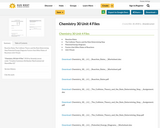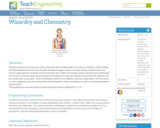
Reaction Rates
The Collision Theory and the Rate Determining Step
Potential Energy Diagrams
Factors that Affect Rates of Reactions
Unit 4 Exam
- Subject:
- Chemistry
- Science
- Material Type:
- Activity/Lab
- Unit of Study
- Date Added:
- 10/18/2018

Reaction Rates
The Collision Theory and the Rate Determining Step
Potential Energy Diagrams
Factors that Affect Rates of Reactions
Unit 4 Exam

Through multi-trial experiments, students are able to see and measure something that is otherwise invisible to them seeing plants breathe. Student groups are given two small plants of native species and materials to enclose them after watering with colored water. After being enclosed for 5, 10 and 15 minutes, teams collect and measure the condensed water from the plants' "breathing," and then calculate the rates at which the plants breathe. A plant's breath is known as transpiration, which is the flow of water from the ground where it is taken up by roots (plant uptake) and then lost through the leaves. Students plot volume/time data for three different native plant species, determine and compare their transpiration rates to see which had the highest reaction rate and consider how a plant's unique characteristics (leaf surface area, transpiration rate) might figure into engineers' designs for neighborhood stormwater management plans.

Through an overview of the components of the hydrologic cycle and the important roles they play in the design of engineered systems, students' awareness of the world's limited fresh water resources is heightened. The hydrologic cycle affects everyone and is the single most critical component to life on Earth. Students examine in detail the water cycle components and phase transitions, and then learn how water moves through the human-made urban environment. This urban "stormwater" water cycle is influenced by the pervasive existence of impervious surfaces that limit the amount of infiltration, resulting in high levels of stormwater runoff, limited groundwater replenishment and reduced groundwater flow. Students show their understanding of the process by writing a description of the path of a water droplet through the urban water cycle, from the droplet's point of view. The lesson lays the groundwork for rest of the unit, so students can begin to think about what they might do to modify the urban "stormwater" water cycle so that it functions more like the natural water cycle. A PowerPoint® presentation and handout are provided.

Students learn how common pop culture references (Harry Potter books) can relate to chemistry. While making and demonstrating their own low-intensity sparklers (muggle-versions of magic wands), students learn and come to appreciate the chemistry involved (reaction rates, Gibb's free energy, process chemistry and metallurgy). The fun part is that all wands are personalized and depend on how well students conduct the lab. Students end the activity with a class duel a face-off between wands of two different chemical compositions. This lab serves as a fun, engaging review for stoichiometry, thermodynamics, redox and kinetics, as well as advanced placement course review.